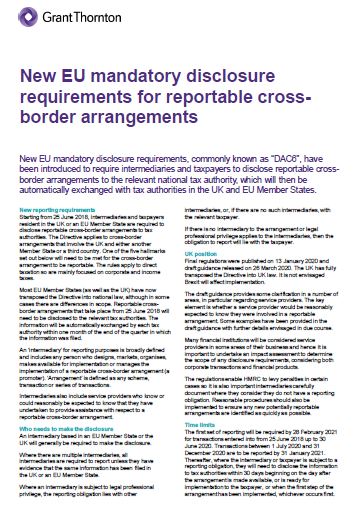-
Corporate Finance and Deal Advisory
We offer a dedicated team of experienced individuals with a focus on successfully executing transactions for corporates and financial institutions. We offer an integrated approach, with our corporate finance specialists working seamlessly with tax and other specialists to ensure that every angle is covered.
-
Digital Risk
Grant Thornton offers solutions to the digital risk issues you are sure to face. Our skilled and experienced security team can helping by advising and consulting, giving you peace of mind, clear value for money and an enhanced ability to react to attacks.
-
Technology Consulting
Motivating and assisting our clients to pursue, maintain and secure the benefits of digital solutions is at the core of our Digital Transformation teams' agenda and goals. We work with business leaders to deliver efficient digital strategies and operating models that provide new or enhanced capabilities.
-
Economic Advisory
Our all-island Economics Advisory team combines expertise in economics and business with a wealth of experience across the public and private sectors.
-
Forensic Accounting
We have a different way of doing business by delivering real insight through a combination of technical rigour, commercial experience and intuitive judgment. We take pride in delivering responsive and tailored solutions to all our clients, capitalising on the wealth of experience housed within our Belfast and wider Forensics team
-
People and Change Consulting
The Grant Thornton People & Change Consulting practice works with clients on these issues as well as on all aspects of how they attract, retain, engage develop, deploy and lead their people.
-
Restructuring
We work with a wide variety of clients and stakeholders such as high street banks, private equity funds, directors, government agencies and creditors to implement solutions which provide the best possible outcomes.
-
Corporate and International Tax
Northern Ireland businesses face further challenges as they operate in the only part of the UK that has a land border with a country offering a lower tax rate.
-
Employer Solutions
Our team specialises in remuneration and incentive planning and works closely with employers, shareholders and employees to ensure that business strategies are aligned and goals achieved in the most tax efficient, cost-effective manner.
-
Entrepreneur and Private Client Taxes
Our team of experienced advisors are on hand to guide you through any decision or transaction ranging from the establishment of new business ventures, to realising value on exit, to succession planning and providing for loved ones.
-
Global Mobility Services
Grant Thornton offer a different approach to managing global mobility. We have brought together specialists from our tax, global payroll, people and change and financial accounting teams across Ireland and Northern Ireland, while drawing on the knowledge and insights of our global network of over 143 offices of mobility professionals to provide you with a holistic approach to managing global mobility.
-
Outsourced Payroll
Our outsourced service provides valued service to over 150 separate PAYE schemes. These ranging from 1 to 1000 employees, working for micro, SME and global employers. The service is supported by the integrated network of tax and global mobility teams and the wider Grant Thornton network delivering a seamless service. Experienced staff deliver a personal service built around your business needs.
-
Tax Disputes and Investigations
Our Tax Disputes and Investigation team is made up of tax experts and former HMRC investigators who have years of experience in dealing with a variety of tax investigations. Our expertise and insight can guide you through all interactions, keeping your cost at a minimum while allowing you to continue with the day to day running of your business.
-
VAT and Indirect Taxes
At Grant Thornton (NI) LLP, our team helps Northern Ireland businesses manage their UK and global indirect tax risks which, as transactional taxes, can quickly become big liabilities.
New EU mandatory disclosure requirements, commonly known as “DAC6”, have been introduced to require intermediaries and taxpayers to disclose reportable cross border arrangements to the relevant national tax authority, which will then be automatically exchanged with tax authorities in the UK and EU Member States.
New reporting requirements
Starting from 25 June 2018, intermediaries and taxpayers resident in the UK or an EU Member State are required to disclose reportable cross-border arrangements to tax authorities. The Directive applies to cross-border arrangements that involve the UK and either another Member State or a third country. One of the five hallmarks set out below will need to be met for the cross-border arrangement to be reportable. The rules apply to direct taxation so are mainly focused on corporate and income taxes.
Most EU Member States (as well as the UK) have now transposed the Directive into national law, although in some cases there are differences in scope. Reportable cross-border arrangements that take place from 25 June 2018 will need to be disclosed to the relevant tax authorities. The information will be automatically exchanged by each tax authority within one month of the end of the quarter in which the information was filed.
An ‘intermediary’ for reporting purposes is broadly defined and includes any person who designs, markets, organises, makes available for implementation or manages the implementation of a reportable cross-border arrangement (a promoter). ‘Arrangement’ is defined as any scheme, transaction or series of transactions.
Intermediaries also include service providers who know or could reasonably be expected to know that they have undertaken to provide assistance with respect to a reportable cross-border arrangement.
Who needs to make the disclosure
An intermediary based in an EU Member State or the UK will generally be required to make the disclosure.
Where there are multiple intermediaries, all intermediaries are required to report unless they have evidence that the same information has been filed in the UK or an EU Member State.
Where an intermediary is subject to legal professional privilege, the reporting obligation lies with other intermediaries, or, if there are no such intermediaries, with the relevant taxpayer.
If there is no intermediary to the arrangement or legal professional privilege applies to the intermediaries, then the obligation to report will lie with the taxpayer.
UK position
Final regulations were published on 13 January 2020 and draft guidance released on 26 March 2020. The UK has fully transposed the Directive into UK law. It is not envisaged Brexit will affect implementation.
The draft guidance provides some clarification in a number of areas, in particular regarding service providers. The key element is whether a service provider would be reasonably expected to know they were involved in a reportable arrangement. Some examples have been provided in the draft guidance with further details envisaged in due course.
Many financial institutions will be considered service providers in some areas of their business and hence it is important to undertake an impact assessment to determine the scope of any disclosure requirements, considering both corporate transactions and financial products.
The regulations enable HMRC to levy penalties in certain cases so it is also important intermediaries carefully document where they consider they do not have a reporting obligation. Reasonable procedures should also be implemented to ensure any new potentially reportable arrangements are identified as quickly as possible.
Time limits
The first set of reporting will be required by 28 February 2021 for transactions entered into from 25 June 2018 up to 30 June 2020. Transactions between 1 July 2020 and 31 December 2020 are to be reported by 31 January 2021. Thereafter, where the intermediary or taxpayer is subject to a reporting obligation, they will need to disclose the information to tax authorities within 30 days beginning on the day after the arrangement is made available, or is ready for implementation to the taxpayer, or when the first step of the arrangement has been implemented, whichever occurs first.


